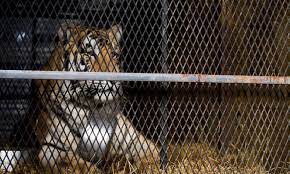It is thought that there is currently about 10,000 big cats in private ownership, often in poor conditions and of no conservation benefit. While as much as 5000 are tigers (more than the 3900 estimated to remain in the wild across all subspecies, and some estimates put the number of tigers as high as 8000) there are also lions jaguars and leopards amongst other species.

Importantly, however well-meaning the owners are, the very existence of this pet trade means that any big cat within easy reach of humans becomes a target. This week the bill: big cat public safety act, passed through the house of representatives. Currently 30 states allow tiger ownership, and a license is just $30. Also, as breeders in the USA have generally mixed up all the subspecies, these tigers do not create a back-stop for the wild population, as these hybrid tigers are unlikely to still have the genetic ability to cope in the extreme heat/cold/desert/flooded area that they used to call home.
The new law will allow big cats to remain with their owner, however they must remain 15foot from the public to prevent contact. This obviously destroys the petting industry, which should reduce the demand for such animals. Quite rightly, many of the lawmakers pointed out that, forgetting for the moment the harm done to the animals in question, and the pet trades threat to the wild populations, it is a public danger. From eating their owner (which happens relatively regularly, to attacking members of the public when the opportunity arises. Indeed, 19 adults and 5 children have died in the last 30 years, and hundreds more have lost limbs or other serious injuries.
Now, laws like this must be written clearly. While sanctuaries nearer home are often better, many wild species are threatened with extinction. It is therefore not a foolish idea to have enough members of the species in captivity, so that should they fully disappear from the wild we have a population with which to re-establish them in their original home range.
This is also still being discussed with regards to the Caspian tiger. Having been extinct in the wild for 50 years, recent analysis shows that the Amur tiger and the Caspian tiger are not genetically distinct enough to be separate sub-species, which means that if the Amur tiger population recovers further, it is possible to re-establish the Caspian tiger population by translocating Amur tigers east. It would also allow tigers to return to other parts of their former range between the two.











